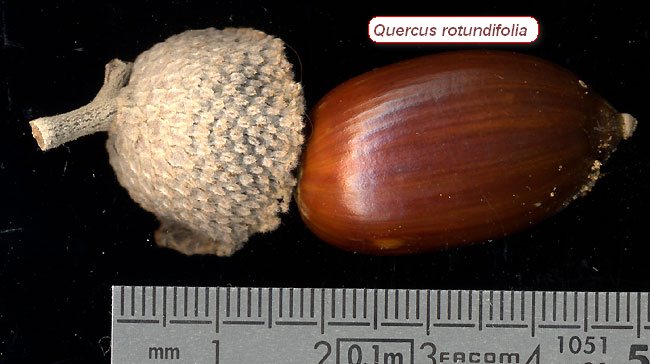| Quercus rotundifolia | |
| Author | Lam. 1785 Encycl. 1: 723 |
| Synonyms | ilex var. rotundifolia
(Lam.) Trab. in Batt. & Trab. 1905 ballota Desf. 1791 ilex subsp ballota (Desf.) Sampaio 1909 avellaniformis Colmeiro & Boulelou 1854 ilex subsp. rotundifolia (Lam.) O.Schwarz ex Tab.- Morais 1940 ilex var. ballota (Desf.) A.DC 1864 alzina Lapeyr. 1813 |
| Local names | |
| Range | South Europe, Algeria, North Africa; 0-2200 m; |
| Growth habit | 10 m tall; |
| Leaves | 1.5-4 cm, rounded on young trees, becoming oval and obtuse; margin sometimes pubescent and toothed (always toothed when young); ash-green or glaucous, slightly pubescent above; pubescent and whiter beneath than those of ilex; petiole 3-12 mm long; only 5-8 vein pairs, not evident beneath; |
| Flowers | male perianths with glabrous, obtuse lobes; 5-12 stamens; |
| Fruits | acorn larger than ilex, and sweet; apex round to pointed; |
|
Bark, twigs and |
bark, buds, twigs like ilex; |
| Hardiness zone, habitat | not quite hardy; |
| Miscellaneous | -- Today,
this taxon is considered as a true species. -- The natural hybrids of Q. rotundifolia are : Q. x airensis, Q. x autumnalis, Q. x diosdadoi, Q. x mixta, Q. x senneniana |
| Subspecies and varieties |
--
there are some varieties : _var. planifolia : leaves 4 cm long, flat, orbicular, entire or nearly so, dark green on both sides, hairless (some stellate hairs beneath); soft bark. _ var. ballota : leaves elliptic-oval, 1.5 times longer than wide. _ var. parviflora : leaves entire, lanceolate, 2-3 X 0.7 cm, with yellowish white pubescence. _ var. grandifolia : leaves 6 x 4 cm. _ var. macrocarpa : very big, elongate, sweet acorn; South Spain. |
| Pictures |
|
.jpg)





